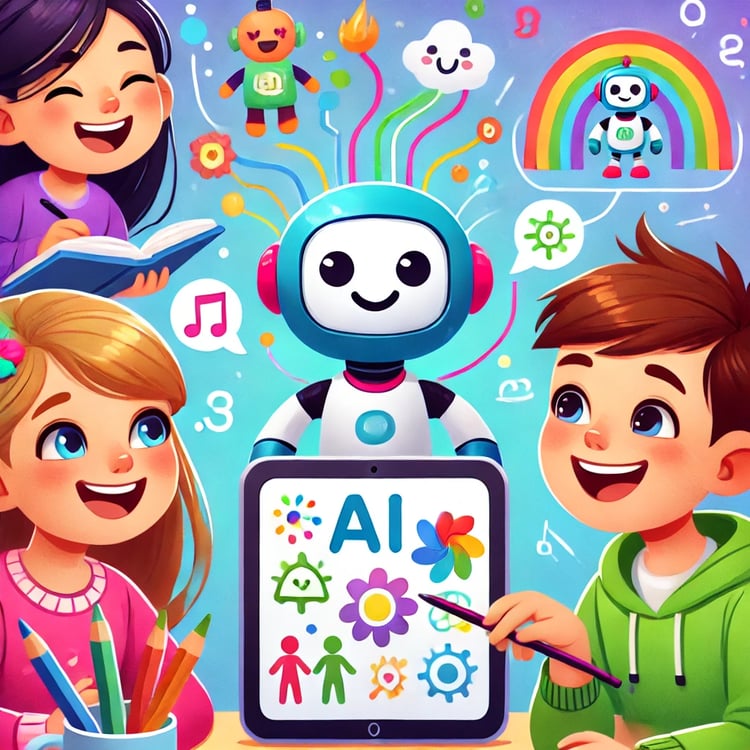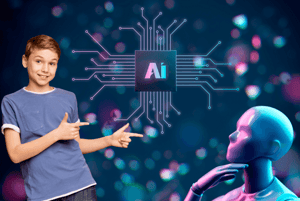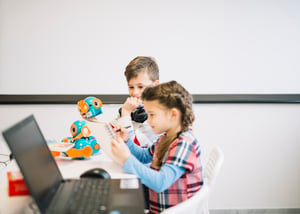Artificial intelligence (AI) is transforming education, especially for kids, by making learning more engaging and personalized. AI-powered apps and platforms adapt to each child’s learning style, offering a fun and effective way to learn. These tools help develop critical thinking and problem-solving skills through interactive experiences.
In this article, we’ll explore the best AI learning tools for kids, their benefits, how to get started, and important safety considerations. Let’s dive into how these innovative tools can make learning an exciting adventure for your child!
Table of Contents
Why AI Learning Tools Are Beneficial for Kids

(This image was generated using Artificial Intelligence)
AI learning tools offer numerous benefits for kids, enhancing their educational experience in several key ways. Firstly, these tools provide personalized learning experiences. By adapting to each child’s pace and learning style, AI can tailor content to meet individual needs, ensuring that no child is left behind or bored with repetitive material. This personalization helps keep kids engaged and motivated, making learning more enjoyable.
Moreover, AI tools enhance critical thinking and problem-solving skills. Interactive platforms often incorporate games and challenges that require kids to think strategically and creatively. This hands-on approach not only makes learning fun but also helps develop essential cognitive skills that are crucial for their future. Additionally, AI learning tools often provide instant feedback, allowing kids to learn from their mistakes and improve continuously.
In essence, AI learning tools offer a dynamic and adaptable learning environment that supports and enhances traditional education methods, preparing kids for a tech-savvy future while making learning an exciting adventure.
Top Interactive AI Learning Tools for Kids

(This image was generated using Artificial Intelligence)
Interactive AI learning tools are transforming education by making it more engaging and personalized. These tools span various subjects, providing kids with a well-rounded educational experience. Let’s explore some of the top interactive AI learning tools for different educational areas.
Coding and Programming
For coding and programming, our CodaKid courses are a fantastic place to start. CodaKid offers a range of interactive courses that teach kids to code through engaging projects, such as creating games and apps. Our platform uses real programming languages like Python and JavaScript, making the learning experience both fun and practical.
Additionally, tools like Scratch and Tynker are excellent for introducing kids to coding. Scratch uses a visual programming language that allows kids to create stories, games, and animations by snapping together code blocks. Tynker offers a similar approach but includes more advanced projects and coding languages as kids progress.
Language Learning
AI-powered language learning apps make mastering new languages exciting for kids. Duolingo Kids, for instance, offers fun and interactive lessons that adapt to each child’s learning pace. The app includes games and exercises that make language learning feel like playtime.
Babbel is another great option, providing structured lessons that focus on vocabulary, grammar, and pronunciation. It’s ideal for older kids who want a more in-depth language learning experience.
STEM Education
STEM education is crucial in today’s tech-driven world, and AI tools like Osmo and LittleBits are perfect for teaching these subjects interactively. Osmo combines physical play with digital learning, using a tablet and tangible game pieces to teach concepts like math, science, and engineering.
LittleBits offers electronic building blocks that kids can use to create a variety of projects, from simple circuits to complex inventions. These tools not only teach STEM principles but also encourage creativity and problem-solving.
Creative and Critical Thinking
For fostering creativity and critical thinking, AI tools like Minecraft: Education Edition and Kahoot! are excellent choices. Minecraft: Education Edition allows kids to explore, build, and problem-solve in a virtual world, making it a powerful tool for learning subjects like history, chemistry, and coding.
Kahoot! is a game-based learning platform that turns quizzes into fun, competitive games. It’s great for reviewing knowledge, sparking discussion, and encouraging critical thinking in a playful environment.
By integrating these AI learning tools into your child’s education, you can provide them with a diverse, engaging, and personalized learning experience that prepares them for the future.
How to Get Started with AI Learning Tools
Starting with AI learning tools can be an exciting journey for both kids and parents. Here are some steps to help you get started:
Identify Your Child’s Interests
Begin by understanding your child’s interests. Are they fascinated by coding, languages, STEM subjects, or creative projects? Knowing this will help you choose the right AI tool that aligns with their passions and keeps them engaged.
Research and Choose the Right Tools
Once you’ve identified your child’s interests, research various AI learning tools available in that category. Look for reviews, features, and age-appropriateness. For coding, explore platforms like CodaKid, Scratch, and Tynker. For language learning, consider Duolingo Kids and Babbel. Tools like Osmo and LittleBits are great for STEM education, while Minecraft: Education Edition and Kahoot! foster creativity and critical thinking.
Start with a Free Trial or Demo
Many AI learning tools offer free trials or demos. Take advantage of these to explore the platform and see if it suits your child’s learning style and interests. This way, you can make an informed decision before committing to a subscription.
Set Up a Learning Schedule
Integrate the AI learning tool into your child’s daily or weekly routine. Consistency is key to making the most of these tools. Set aside specific times for using the tool, ensuring it complements their regular schoolwork and activities without becoming overwhelming.
Monitor Progress and Provide Support
Regularly check your child’s progress and be available to provide support when needed. Celebrate their achievements to keep them motivated and address any challenges they might face. Encourage them to explore different features of the tool and try new projects or lessons.
Stay Updated and Involved
AI learning tools often update their content and features. Stay informed about these updates to make sure your child is benefiting from the latest educational resources. Additionally, join online communities or forums related to the tool to share experiences and get tips from other parents and educators.
By following these steps, you can help your child get the most out of AI learning tools, making their educational journey both fun and productive.
Safety and Privacy Considerations

(This image was generated using Artificial Intelligence)
When using AI learning tools for kids, safety and privacy are crucial. Here are some key considerations:
- Choose Kid-Friendly Platforms: Ensure the tools are designed for kids with appropriate content and parental controls. Look for COPPA-compliant platforms.
- Monitor Screen Time: Balance educational screen time with other activities to maintain a healthy routine.
- Protect Personal Information: Teach kids not to share personal details online and choose platforms with strong privacy policies.
- Use Secure Devices: Keep devices secure with updated antivirus software to protect against online threats.
- Stay Involved: Regularly check in on your child’s activities and engage with them about their learning experiences.
By following these tips, you can ensure a safe and enriching learning environment for your child while using AI tools.
Future of AI in Kid’s Education
The future of AI in education for kids is bright and full of potential. AI technologies are set to revolutionize how children learn, making education more personalized and effective.
Enhanced Personalization
AI will continue to advance in personalizing learning experiences. By analyzing a child’s learning style, pace, and interests, AI can tailor lessons to fit their unique needs. This ensures that each child can progress at their own speed, mastering subjects before moving on.
Interactive and Immersive Learning
The integration of virtual reality (VR) and augmented reality (AR) in AI learning tools will create immersive educational experiences. Imagine children exploring ancient civilizations in VR history lessons or conducting virtual science experiments. These technologies make learning more engaging and can help simplify complex concepts.
Adaptive Assessments
AI will refine adaptive assessments, which provide real-time insights into a child’s strengths and areas for improvement. These assessments adjust in difficulty based on the child’s performance, offering a more accurate measure of their understanding and skills. This helps teachers and parents support their child’s learning journey more effectively.
Collaboration and Communication
Future AI tools will enhance collaboration and communication among students, teachers, and parents. Real-time feedback and interactive platforms will allow for seamless communication, helping to address learning challenges promptly and encouraging collaborative projects.
Expanding Access to Quality Education
AI has the potential to democratize education by making high-quality learning resources available to children worldwide. Online AI-powered platforms can reach remote and underserved areas, providing valuable educational opportunities to those who might otherwise lack access.
Preparing for a Tech-Driven Future
As AI becomes more integrated into education, children will develop essential skills for the future. Learning to interact with AI, understanding its applications, and using it as a tool will prepare them for a world where technology plays a central role in everyday life.
Unlock Your Child’s Potential with AI Learning Tools
AI learning tools are transforming education by making it more personalized, engaging, and effective. These tools offer unique benefits like tailored learning experiences and enhanced critical thinking skills. From coding and programming with platforms like CodaKid to language learning, STEM education, and fostering creativity, AI tools cater to diverse interests and needs.
To get started, identify your child’s interests, choose the right tools, and integrate them into their routine. Prioritize safety and privacy to ensure a secure learning environment. The future of AI in education promises even more exciting advancements, preparing children for a tech-driven world.
Explore the possibilities and unlock your child’s full potential with AI learning tools. Start your journey with CodaKid today and make learning an exciting adventure!

















